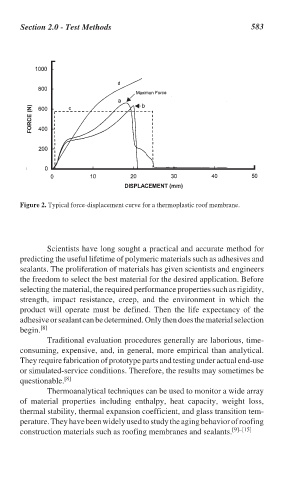Page 615 - Handbook of Thermal Analysis of Construction Materials
P. 615
Section 2.0 - Test Methods 583
Figure 2. Typical force-displacement curve for a thermoplastic roof membrane.
Scientists have long sought a practical and accurate method for
predicting the useful lifetime of polymeric materials such as adhesives and
sealants. The proliferation of materials has given scientists and engineers
the freedom to select the best material for the desired application. Before
selecting the material, the required performance properties such as rigidity,
strength, impact resistance, creep, and the environment in which the
product will operate must be defined. Then the life expectancy of the
adhesive or sealant can be determined. Only then does the material selection
begin. [8]
Traditional evaluation procedures generally are laborious, time-
consuming, expensive, and, in general, more empirical than analytical.
They require fabrication of prototype parts and testing under actual end-use
or simulated-service conditions. Therefore, the results may sometimes be
questionable. [8]
Thermoanalytical techniques can be used to monitor a wide array
of material properties including enthalpy, heat capacity, weight loss,
thermal stability, thermal expansion coefficient, and glass transition tem-
perature. They have been widely used to study the aging behavior of roofing
construction materials such as roofing membranes and sealants. [9]–[15]

